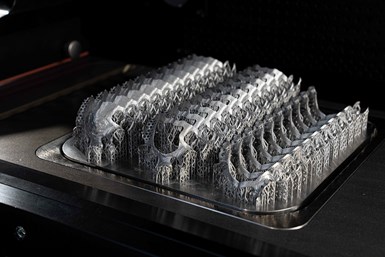Trumpf Optimizes TruPrint 2000 for Mass Production
With its motorized beam expander, the TruPrint 2000 is flexible as it can automatically adjust the spot diameter of the laser to the task at hand.
Trumpf has further increased the productivity of its TruPrint 2000 3D printer, which now comes with a square build plate and the increased power of a 500-W integrated fiber laser offered as an alternative to the 300-W laser in the basic configuration.
When using a square build plate, dental technology companies, for example, can print up to 36% more removable partial dentures than they could on a comparable round build plate.
“The updated TruPrint 2000 is further optimized for mass production. Users from all industries benefit from the machine's high productivity,” says Miguel Verdejo, additive manufacturing product and project manager at Trumpf’s Laser Technology Center in Michigan.
As a multilaser version, the TruPrint 2000 has two lasers. Both lasers can process the entire build plate simultaneously, resulting in optimized throughput for production. “The TruPrint 2000 is productive, precise and produces high quality parts,” Verdejo says.
According to the highest medical standards, medical technology manufacturers can use the 3D printer to produce skull plates, spine cages or knee joints made of titanium, for example. “In addition to the upgrades of the TruPrint 2000, the machine has the process monitoring and calibration features found in all TruPrint machines. Ensuring repeatable and high-quality parts is the top priority for Trumpf3D printing, especially in critical areas such as medical and dental technology.”
With its motorized beam expander, the TruPrint 2000 is especially flexible as it can automatically adjust the spot diameter of the laser to the task at hand. Depending on the application, the spot diameter is 55 or 80 m. The 80-m spot enables higher productivity. Users can use the 55-m spot when special metal powders require a higher energy density. The introduction of the 80-m spot size brings the TruPrint 2000 in line with the rest of the machines in the TruPrint portfolio.
“With this standardization, users can now easily transfer the parameters for printing their parts from one machine type to another, such as from a TruPrint 2000 to a TruPrint 1000 or TruPrint 3000, which enables for more flexible production,” Verdejo says.
Related Content
-
Cranial Implant 3D Printed From Hydroxyapatite Ceramic: The Cool Parts Show #76
Cranial implants are typically made from titanium or PEEK; in this episode of The Cool Parts Show, we look at how implants made from a bioceramic can improve osseointegration and healing.
-
3D Printed PEEK Spine Implants in Production: The Cool Parts Show Bonus
Curiteva is using Fused Strand Deposition to produce two different lines of FDA-cleared spine implants. We visited the company’s Huntsville, Alabama, facility to learn more.
-
8 Cool Parts From Formnext 2023: The Cool Parts Show #65
New additive manufacturing technologies on display at Formnext were in many cases producing notable end-use components. Here are some of the coolest parts we found at this year’s show.















